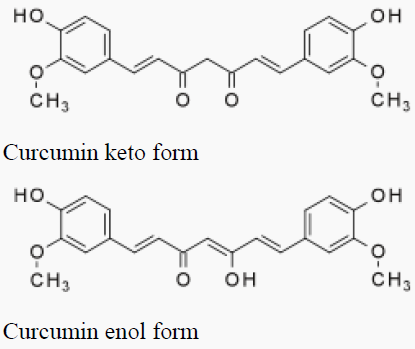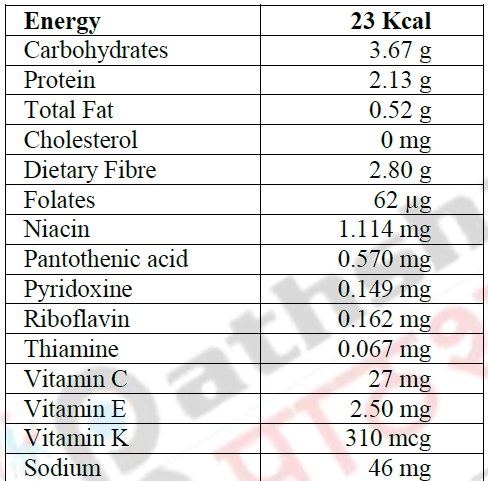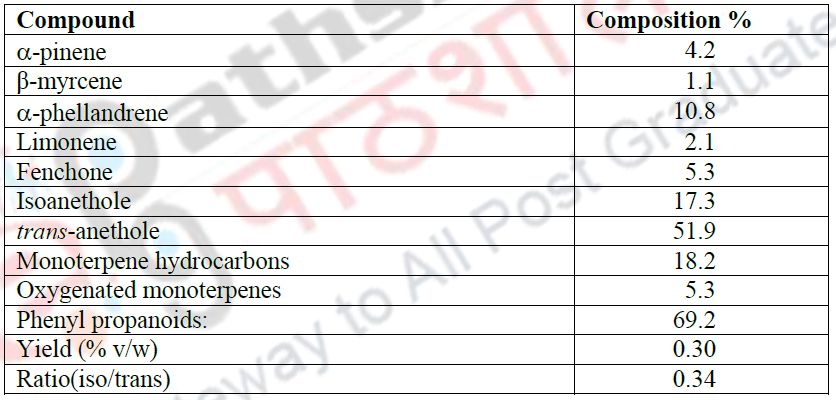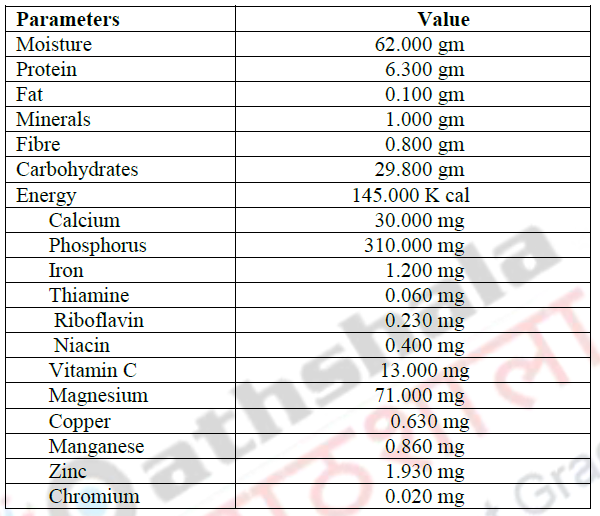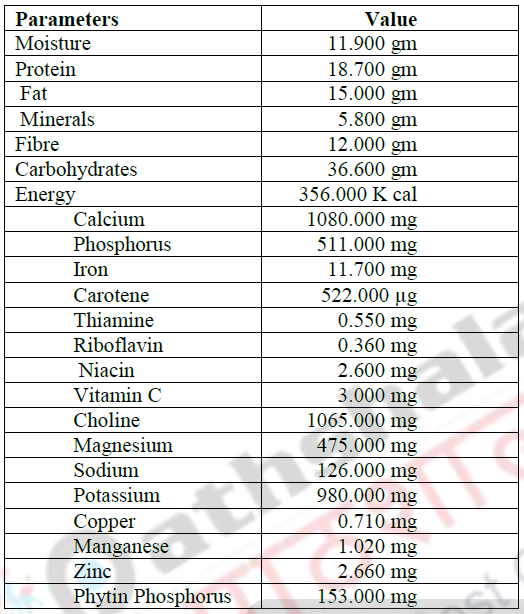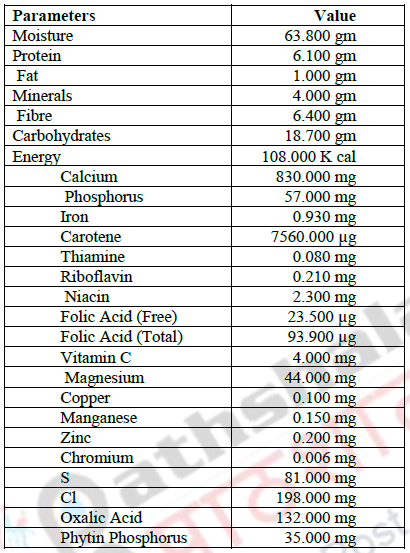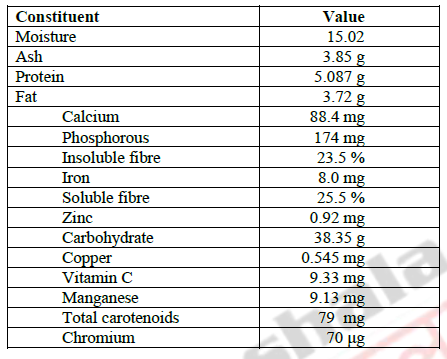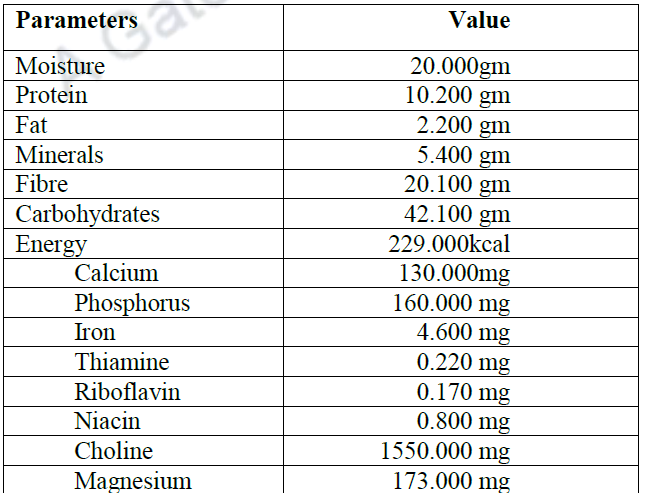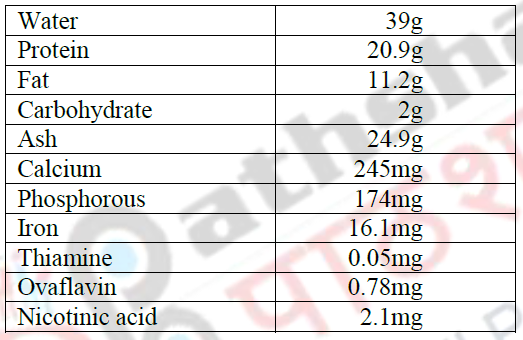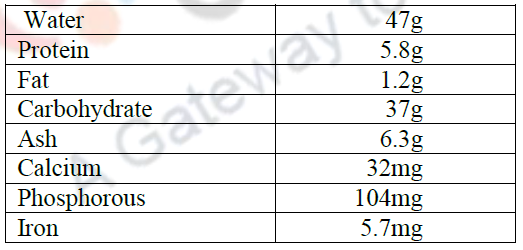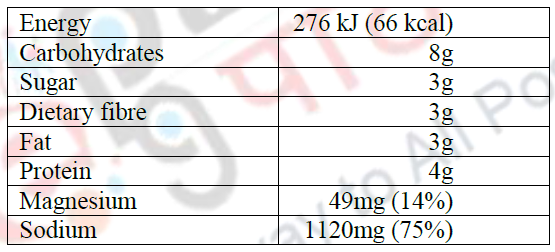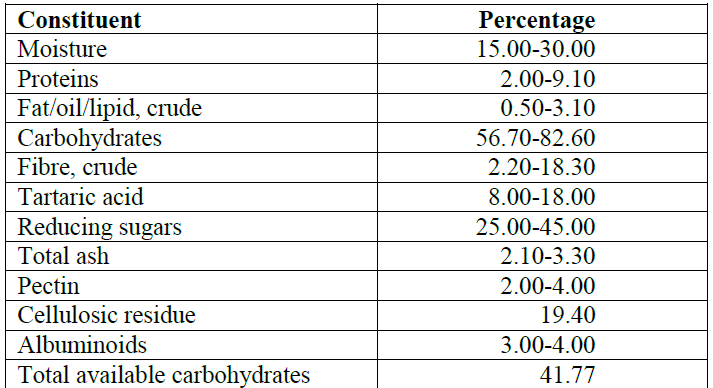6 Chemical composition of spices and condiments
6.1. Spices:
6.1.1. Turmeric
Turmeric is an antioxidant phytochemical known as a polyphenol and has the chemical composition of C21H20O6. It contains a mixture of phenolic compounds called curcumin about 5%, and related compounds called curcuminoids, and a volatile oil about 5% with turmerone and zingiberene; cineole and other monoterpenes; starch; protein; and high amounts of vitamin A and other vitamins like vitamin C and E,several carotenoids, curcumin.
Functions:
- Curcumin is one of the antioxidants.
- Cineole stimulates central nervous system and is antiseptic.
- Essential oil has stimulating effects on the gallbladder and also stimulates the liver to produce more bile and regulate its viscosity.
Curcumin exists in two forms, keto and enol. Keto form is preferred in solid phase while enol form in solution and is a PH indicator as it turns yellow in acidic solution and bright red in basic solution.
6.1.2. Coriander
Leaves and seeds contain many essential volatile oils such as borneol, linalool, cineole, cymene, terpineol, dipentene, phellandrene, pinene and terpinolene. In addition to this they are also rich in numerous anti-oxidant polyphenolic flavonoids such as quercetin, kaempferol, rhamnetin and epigenin.
Fruits contain 0.2–2.6% volatile oil. The major component of the oil is d-linalool(coriandrol), which is present in 55–74%. Other compounds present in the oil include decyl aldehyde, borneol, geraniol, geranyl acetate, camphor, carvone, anethole, caryophyllene oxide, elemol, and monoterpene hydrocarbons (mainly γ-terpinene, and α- and β-pinene, d-limonene, p-cymene,β-phellandrene and camphene). Other constituents present in fruits include up to 26% fats made up of glycerides (primarily of oleic, petroselinic and linolenic acids), a small amount of unsaponifiable matter (containing β-sitosterol, δ-sitosterol, triacontane, triacontanol, tricosanol, etc.); proteins (11–17%); about 1.0% starch and 20% sugars; coumarins; flavonoid glycosides, and rutin.
Leaves contain less volatile oil than fruits; about 5% fats; about 22% proteins; sugars; coumarins and flavonoid glycosides similar to those in fruits; vitamin C; and others. The volatile oil contains mainly decyl and nonyl aldehydes, and linalool, among others. The herb is a good source of minerals like potassium, calcium, manganese, iron, and magnesium. It is also rich in many vital vitamins, including folic-acid, riboflavin, niacin, vitamin-A, beta carotene.
Nutrient value per 100 g
6.1.3. Fennel
The main chemical components of fennel oil are a-pinene, myrcene, fenchone, trans- anethole, methyl chavicol, limonene, 1, 8-cineole and anisic aldehyde.
Fruits contain 1.5–8.6% volatile oil; 9–28% fixed oil composed primarily of petroselinic acid (60–75%), oleic acid, and linoleic acid with a relatively high concentration of tocopherols; flavonoids (mainly quercetin-3-glucuronide, rutin, isoquercitrin, and quercetin-3-arabinoside); protein (16–20%); sugars; vitamins; minerals; and others. Low concentrations of polyacetylenes were recently detected in the root. An antimicrobial phenyl propanoid was also isolated from the stem.
The volatile oil contains mostly trans-anethole (72–74%), with lesser amounts of fenchone (11–16%), estragole (methyl chavicol, 3–5%), limonene, camphene, and α-pinene. Other compounds present include monoterpene hydrocarbons (β-pinene; α-thujene, α-fenchene, 3-carene, sabinene, α-phellandrene, myrcene, α- and β-terpinene,terpinolene, and p-cymene), fenchyl alcohol.
Chemical category of fresh fennel:
Essential oil composition of fennel plant
Twenty four constituents were present in fennel which constitute 97.0% of the total essential oil components .Phenol ethers was the main chemical category (72.7%) followed by monoterpene hydrocarbons (17.6%). The major essential oil constituents were trans-anethole (55.5%) followed by isoanethole (17.2%), α-phellandrene (10.3%), fenchone (5.0%) and α-pinene (3.4%).
6.1.4. Fenugreek
Fenugreek contains simple alkaloids consisting mainly of trigonelline (up to 0.13%), choline (0.05%), gentianine, and carpaine. Other constituents include:
- Saponins that yield on hydrolysis 0.6–1.7% steroid.
- Flavonoids, including vitexin.
- Fixed oils (5–8%), which on extraction with fat solvents yield an extract with a strong odour.
- Considerable amount of mucilage, which appears to be mostly a galactomannan and is probably responsible for swelling of the seed in water.
- Protein (23–25%), which is low in S-amino acids but high in lysine and tryptophan.
- Free amino acids, including (2S, 3R, 4R)-4-hydroxyisoleucine, histidine, lysine, and arginine.
- Vitamins, especially A, B1, and C.
- Minerals (especially calcium and iron).
- Volatile components (more than 50), which include n-alkanes, Sesquiterpene, and oxygenated compounds.
Garlic contains more than 200 chemical compounds. Some of the important ones include: volatile oil (0.1–0.36%) with sulphur-containing compounds: (allicin, alliin, and ajoene), protein (16.8%) and enzymes: (allinase, peroxidase and myrosinase). Allicin is what gives garlic its antibiotic properties and is responsible for its strong odour. Garlic also contains citral, geraniol, linalool, A phellandrene and B phellandrene.
Vitamin and Mineral Content: B-vitamins especially B1, vitamin C, vitamin A, flavonoids, ascorbic acid, thiamine, riboflavin, niacin phosphorous, potassium, sulphur, selenium, calcium, magnesium, germanium, sodium, iron, manganese and trace iodine. Seventeen amino acids are found in garlic, including eight essential ones.
6.1.6. Clove
Cloves are actually the dried buds of the clove tree. The minor constituents like methyl amyl ketone, methyl salicylate, are responsible for the characteristic pleasant odour of cloves. Clove oil is comprised of many different compounds, with the primary component being eugenol (49–87%), β- caryophyllene (4–21%), and eugenyl acetate (0.5–21%). Smaller amounts of a-humulene, methyl eugenol are also present, as well as trace amounts (<1%) of 25–35 other constituents. Cloves also contain flavonoids, galloyltannins, phenolic acids and tri-terpenes.
Several factors govern the relative quantities of the different constituents in clove oil, including plant genetics, climate, soil and cultivation techniques, the part of the plant extracted, and the extraction method.
6.1.7. Cumin
Among the spices cumin is having highest antioxidant activity and these antioxidants also act as preservatives by preventing or slowing the spoilage of food.
Among the seed spices, cumin fruits have a distinctive bitter flavour and strong, warm aroma due to their abundant essential oil content. Cumin-aldehyde (40 to 65%) is the major constituent and important aroma compound. The characteristic flavour of cumin is due to the presence of monoterpenes such as α-pinene and cis-β-farnesene.
6.1.8. Capsicum
Capsaicin and dihydrocapsaicin are the main capsaicinoid in chilli pepper while nordihydrocapsaicin, homodihydrocapsaicin and homocapsaicin are the minor capsaicinoids. Capsaicin is synthesized in interlocular septum of chilli pepper and is made from vanillylamine and 8- methyl-6-nonenoyl CoA.
6.1.9. Pepper
Pepper gets its spicy heat mostly from the piperine compound, which is found both in the outer fruit and in the seed. Black pepper contains between 4.6% and 9.7% piperine while white pepper contains slightly more than that. Black pepper contains 2–4% volatile oil and 5–9% piperine, piperidine, piperettine, and a few minor alkaloids (piperyline, piperolein A, piperolein B, piperanine, etc.). Piperine and piperanine are the known pungent principles. Black pepper oil contains β and α- pinenes, δ-Iimonene and β-caryophyllene as major components. Caryophyllene is the substance with sweet floral odours, whereas oils with high pinene content give turpentine like off-odours. The major compounds in the fresh pepper are trans – linalool oxide and α-terpineol.
Black pepper is also reported to contain flavonol glycosides (especially those of kaempferol, rhamnetin, and quercetin) in considerable concentration, as well as sterols (stigmastane-3, 6-dione and stigmast-4-ene-3, 6-dione) and polysaccharides.
6.1.9.1. A typical chemical composition of black pepper :
White pepper contains little volatile oil but has the same pungent principles and alkaloids as black pepper. Both also contain about 11% protein, 65% carbohydrates, lipids, crude fibre, and others. Pepper oil contains a complex mixture of monoterpenes (70–80%), Sesquiterpene (20–30%), and small amounts of oxygenated compounds, with no pungent principles present. Major monoterpenes include α-thujene, α-pinene, camphene, sabinene, β-pinene, myrcene, 3-carene, limonene, and β- phellandrene. Sesquiterpenes include β-caryophyllene (major component), β-bisabolene, β-farnesene, curcumene, humulene, β-selinene, α-selinene, β-elemene; α-cubebene, α-copaene, and sesquisabinene. Oxygenated components include linalool, l-terpinen-4-ol, myristicin, β-pinone etc.
6.1.10. Curry leaf
The curry leaf plant is highly valued for its characteristic aroma and medicinal value. A number of leaf essential oil constituents and alkaloids have been extracted from this plant. There are a large number of oxygenated mono and Sesquiterpene present, for example, cis-ocimene (34.1%), β- caryophyllene (9.5%), α-pinene (19.1%), δ-terpenene (6.7%) and β- phellandrene which appear to be responsible for the intense odour associated with the stalk and flower parts of curry leaves.
6.1.11. Ginger
Ginger owes its characteristic organoleptic properties to two classes of constituents. The aroma of ginger are due to the constituents of its steam-volatile oil which are mainly Sesquiterpene hydrocarbons, monoterpene hydrocarbons and oxygenated monoterpenes while its pungency is due to the non-steam-volatile components also known as the gingerols. The major Sesquiterpene hydrocarbon constituent of ginger oil is α–zingiberene. Certain ginger oil has a reputation for possessing a particular ‘lemony’ aroma, due to its high content of the isomers, neral, and geranial often collectively referred to as citral. The antioxidant components analysed were polyphenols, vitamin C, β carotene, flavonoids and tannins.
6.1.11.1. Nutritional composition of ginger (per 100g)
6.1.12. Cardamom
The main chemical components of cardamom oil are a-pinene, β pinene, sabinene, myrcene, a-phellandrene, limonene, methyl eugenol and trans-nerolidol. It contains 2.8–6.2% volatile oil, 10% protein, 1–10% fixed oil, up to 50% starch, manganese, and iron, among others. The volatile oil is composed mainly of α-terpinyl acetate and 1,8-cineole, each of which may be present at concentrations of up to 50% or more; lesser components include limonene, sabinene, linalool, linalyl acetate, α-pinene, α-terpineol, camphene, myrcene, 1,4-cineole, borneol,etc. Acid constituents of the oil include acetic, butyric, decanoic, dodecanoic, citronellic, geranic, hexanoic, heptanoic, nerylic, and perillic acids. The fixed oil mainly consists of waxes containing n-alkanes and sterols.
6.2. Condiments:
6.2.1. Vinegar
It is a liquid substance consisting mainly of acetic acid (CH3CO2H) and water. Acetic acid is produced mainly through the fermentation of ethanol by acetic acid bacteria. Generally vinegar contains extract, ash, volatile acid, non volatile acid, reducing sugar, the concrete substances present are higher alcohols, 3-hydroxybutanone, dihydroxy acetone, tyrosol, acetal -dehyde, formaldehyde, acetal, acetic acid (the content is 3 to 5 %), succinic acid, oxalic acid and sorbose.
6.2.2. Thick sauce
In every 100g of thick sauce, there are:
In every 100g of sweet sauce made from fermented flour, there are:
6.2.3. Hot sauce
There are many recipes for hot sauces – the common ingredient being any kind of chilli pepper. A group of chemicals called capsaicinoids are responsible for the heat in chilli peppers. The peppers are infused in anything from vinegar, oil, water, beer and alcohol to fruits and vegetable pulp. Additional ingredients are often used, including those used to add extra heat, such as pure capsaicin extract and mustards.
6.2.4. Oliveoil
Olive oil is a fat obtained from the olive fruit. The oil is produced by grinding whole olives and extracting the oil by mechanical or chemical means.
Saturated fats:
Palmitic acid: 7.5–20.0%
Stearic acid: 0.5–5.0%
Arachidic acid: <0.6%
Behenic acid: <0.3%
Myristic acid: <0.05%
lignoceric acid: <0.2
Monounsaturated fats:
oleic acid: 55.0–83.0%
palmitoleic acid: 0.3–3.5%
linoleic acid: 3.5–21.0 %
a-linolenic acid: <1.0%
6.2.5. Mustard
Mustard is often used at the table as a condiment on meat.
Nutritional value per 100 g (3.5 oz)
6.2.6. Table salt
It is composed mainly of sodium chloride. It is a refined salt containing about 97 to 99% sodium chloride (Nacl) and anti-caking agents like sodium alumina-silicate or magnesium carbonate to make it free-flowing. Some other anti caking agents include tricalcium phosphate, calcium carbonate, calcium silicate, sodium alumina-silicate and calcium alumina-silicate. However additives may also be added. Iodine containing compounds are added to table salt like potassium iodide, sodium iodide, or sodium iodate. Small amount of dextrose is added to stabilize the iodine. Iodized salt is used to reduce the incidence of iodine deficiency in humans.
6.2.7. Wasabi:
The volatile for pungency is allyl isothiocyanate produced by hydrolysis of natural rhizome thioglucosides and the reaction is catalyzed by myrosinase.
100g of wasabiroot contains:
- Calories : 109 kcal
- Fat: 0.63 g
- Carbohydrates: 23 g
- Fibre: 7.8 g
- Protein: 4.8 g
6.2.8. Ketchup:
Ketchup has health benefits which are offset by the salt and sugar content. Ketchup is a source of lycopene, an antioxidant which may help prevent some forms of cancer.
Nutrient (per 100 g)
6.2.9. Tamarind
Contains plant acids (16–18%) composed mainly of d-tartaric acid, with minor amounts of l– malic acid. Other constituents include polyphenolics (catechin, epicatechin, and procyanidin), flavonoids (taxifolin, apigenin, luteolin, and naringenin), sugars (20–40%), pectin, protein (2.8%), fat, vitamins (e.g., B1 and C), minerals (Ca, K, P, etc.), and tartrate.
It also contains a volatile fraction that consists of over 60 identified compounds, including limonene, terpinen-4-ol, neral, α-terpineol, geranial, and geraniol, which are responsible for its citrus taste; methyl salicylate, safrole, ionones (β- and γ-), cinnamaldehyde, and ethyl cinnamate, which contribute to warm spicy taste; piperitone; and several pyrazines and alkylthiazoles are also present.
Proximate composition per 100g
| you can view video on Chemical Composition of Spices and condiments |

